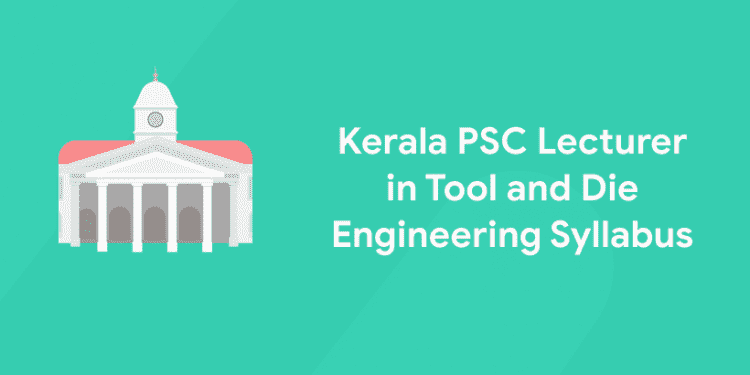Kerala Public Service Commission (KPSC) will recruit eligible and efficient candidates to the Lecturer post in Engineering and Polytechnic colleges soon! Candidates with First Class Bachelors Degree in appropriate branch of Engineering/Technology from a recognized university after undergoing a regular course of study can apply for the post through official website of Kerala PSC. Candidates will be selected on the scores that they scored on the Written examinations as the part of Kerala PSC recruitment process. Here is the Kerala PSC Lecturer in Tool and Die Engineering Syllabus.
Subscribe to Kerala PSC Gold and Learn with Entri!
Kerala PSC Lecturer in Tool and Die Engineering Syllabus
The syllabus of Kerala PSC Lecturer in Tool and Die Engineering with full details are given below. Start your exam preparation with the Syllabus provided by the KPSC and the learning support from Entri team!
Download the KPSC Lecturer in Tool and Die Engineering Syllabus PDF
Part 1: Module 1
a) Technical Mathematics
I. Matrices – Identification of Matrices, matrix operations, adjoint and inverse.
II. Determinants – Evaluation of second and third order, minors and cofactors, solutions of simultaneous linear equation in three unknown using Cramer’s rule.
III. Binomial Series – Expansions using Binomial theorem.
IV. Trigonometric functions – Signs of functions in each quadrant. Trigonometric values of angles, properties of trigonometric functions, applications of the identities sin (A ± B), cos (A ± B) and tan (A ± B).
V. Coordinate geometry – Equations to a straight line – slope-intercept form, intercept form, Angle between two lines, condition for two lines to be perpendicular, parallel.
VI. Differentiation – Limits and continuity, derivatives of functions, equation to tangents and normals. Maxima and minima of functions of one variable.
VII. Integration of functions – Integration of different types of functions.
VIII. Applications of integration – Area bounded by a curve and X or Y axis, solutions of differential equations using the method of variable separable, solutions of linear differential equations of first order.
b) Basic Civil Engineering
- Materials: Brick – varieties and strength, characteristics of good brick. Cement – varieties and grade of cement and its uses. Steel – types of steel for reinforcement bars, steel structural sections. Aggregates – types & requirements of good aggregates. Concrete – grades of concrete as per IS code, water cement ratio. Workability, mixing, batching, compaction and curing.
- Construction: Parts of building – foundation – types of foundations – spread footing, isolated footing, combined footing, Raft, pile and well foundations. Masonry – types rubble masonry, brick masonry, English bond and Flemish bond. (One brick wall).
- Surveying: Chain surveying – principles, instruments, ranging, and chaining survey lines, field work and field book, selection of survey stations, units of land area.
- Levelling: Levelling instruments, different types, bench mark, reduced level of points, booking of field notes, reduction of levels by height of collimation method (simple problem). Modern survey – instruments – Total station, Electronics theodolite, Distomat.
c) Basic Mechanical Engineering
- The importance of IC Engines: Definition, classification – two stroke engines, four stroke engines, working of two stroke engines and four stroke engines with the help of line sketches, comparison between two stroke and four stroke engines, comparison between petrol and diesel engines, function of fly wheel, clutch, gearbox, propeller shaft and differential in power transmission, explain with sketch the working of differential, briefly explain power transmission of 4 wheel vehicle with line diagram.
- The importance of Power Plants: Introduction, classification of power plants – working of hydroelectric power plant with schematic sketches – working of thermal (Steam and Diesel) power plant with schematic sketches – working of nuclear power plant with schematic sketches.
d) Basic Electrical Engineering
- Review with discussion of electric current, potential difference, power, EMF, resistance and its laws, Ohms law and series parallel circuit, electromagnetism, generation of AC and DC supply.
- Idea of Basic electrical circuit
- Circuit parameters
- Electrical circuit of an installation
e) Essentials of Electronics Engineering
- Active and passive devices
- Switches
- Microcontrollers
- Mobile technology
- Inverter & UPS
- E-waste
Part 2: Module 1 Press Tool Technology and Tool Design
Press Tool Operations: Piercing, Blanking, Lancing, extrusion, embossing, coining, bending, drawing, swaging, shaving, deep drawing etc. Press Tools – Guide Plate Tool, Progressive Tool, Compound tool and Combination Tool Strip layout – % utilization. Punches – Cutting and non cutting punches, hybrid punches – Load on punches – size determination – clearance, punch, die size, die block – solid, split. Strippers – types, box, fixed, travellers, stripping force for blanking and piercing – fool proofing – pilots – purpose – direct and indirect pilots – size – methods of piloting. Side Cutters – Functions, advantages. Ejectors and Shedders – Functions and Types.
Knockouts – Functions. Fasteners and dowel – Screws, function, types – socket head, counter sunk, cheese head, Rivets, Cotter pin. Positing of screws. Die sets – Types, precision and commercial / standard and non-standard, top plate, bottom plate, guide pillar material, Shut height. Press – parts, capacity, power – mechanical, hydraulic, pneumatic, press selection. Blank development for cylindrical shell – Algebraic method, graphical method, Layout
method, CG method. Fine Blanking – Calculation of Punch and die, materials suitable for fine blanking – work
hardening – steel, copper and copper alloys.
Module II : Moulds and Dies Technology, Material Technology
Moulds and Dies Technology:
Plastics in the mould Industry, properties, applications processing Techniques – Injection moulding, principle, applications, Injection Moulding machines – Shot weight calculations, Plasticizing capacity, Clamping force – Number of cavity calculation – Testing of plastics – visual Test, Smoke Test, Carbon Black Test – Terminology, mould materials, feed system – Runner, types of runner, runner dia calculation, gate – Types of Gates, Ejection Techniques, Ejection force calculation.
Venting, shrinkage, parting surface. Factors governing shrinkage, cooling – mould cooling calculation. Side core and side cavity – two, three plate moulds, runner less moulds, multi daylight moulds – mould maintenance – compression moulding – applications, basic types – Flash, positive, landed positive, semi positive. Transfer moulds – application – advantages and limitations.
Material Technology:
- Mechanical properties of materials
- Structure of material
- Classification of Cast Iron
- Production and properties of Steel
- Effect of alloying elements on properties of steel
- Properties and uses of alloy steel
- Nonferrous metals and alloys in Engineering application
- Destructive and Non-destructive Tests
- Heat Treatment
- Heat Treatment of Tool Steel
- Polymers
Module III : Production Technology & Engineering Metrology
- Metal Joining
- Welding – Fusion and non-fusion.
- Resistance Welding – spot, seam, projection, butt and percussion
- Other welding methods – Thermit, TIG, MIG, Ultrasonic, Plasma Arc, Electron Beam and Laser Beam.
- Gas Welding
- Lathe
- Cutting speed, feed and Depth of cut.
- Lathe operations
- Drilling machines
- Grinding and Grinding machine
- Milling Machines
- Plain milling
- Cutting fluid
- JIG Boring Machine
- Surface finishing and Coating
- Broaching
- Die sinking and engraving
- NC machines
- NC / CNC / DNC
- CAD – CAM
- FMS – Basic components of FMS.
Engineering Metrology
- Definitions
- Linear measurements & Angular measurements
- Precision Instruments
- Gauges
- Dial Gauge
- Comparator
- Surface finish
- Calibration
- Measuring machines
Module IV : Applied Mechanics, Strength of materials & Fluid Mechanics
- Direct Stresses and Strains
- Friction
- Centre of Gravity of Sections
- Moment of Inertia
- Riveted Joints
- Welded Joints
- Thin Cylinders
- Torsion of Circular Shafts
- Springs
- Shear Force and Bending Moment
- Types of loading
- Deflection of beams
- Columns and Struts
Try Out Kerala PSC Mock Tests on Entri!
Fluid Mechanis, Pneumatics
- Properties of Fluid
- Fluid Pressure and Measurements
- Kinematics and Dynamics of Fluid Flow
- Flow through Orifices, Notches, Pipes and Nozzles
- Fluid Power
- Hydraulic System
- Hydraulic Control Elements and Components
- Hydraulic Circuits
- Turbine
- Control Elements and Components
- Pneumatic Circuits
- Hydro Pneumatic System
Module V : Industrial Management and Engineering
Industrial Management
- Principles of Management
- Wage Payment System
- Quality Planning and its developments
- Project Management Techniques
- Quantitative techniques in Management
- Materials and Sales Management
Industrial Engineerning
- Production Planning and Control: Concepts of industry – Production and productivity – types of production – Job production, batch production, mass production, continuous production – Planning and control – Definitions, benefits and functions. Pre-planning activities – Forecasting, plant location, product planning, design and development, material selection.
Process planning, determination of men, machines, material and tool requirements – Process planning – Choice of machine in process planning – Break even analysis – Process sheet – Process planning procedure – Routing – Scheduling – Dispatching – value engineering – Plant location and layout – plant layout – Plant maintenance – Types of maintenance. - Method Study: Work study – Advantages, applications – Method study – Therbligs and their symbols – Process chart – preparation of operation process chart, flow process chart, man-machine chart, right hand and left hand process chart, SIMO chart – Flow diagram – Principles of motion economy – Rules concerning human body, work place layout and material handling, tools and equipments – work measurement – stop watch time study – standard time calculation – Production study – work sampling.
- Inspection and Quality Control: Quality and quality control – product control – Inspection- Types – Advantages and limitations.
- Fundamental of Statistical Concepts: Variability in measurements – Terms – variable, attribute, frequency, frequency distribution and frequency plot – Normal distribution curve, Tally sheet, Mean, mode, median and standard deviation Control charts – X, R, P, 100P and C.
- Project Analysis: Need and scope – Elements of project analysis – Production cost – Market survey – Selling price – Capital investment – Return on investment – Elements of costing – Classification of cost – Depreciation – Types.
Entri wishes you good luck for your upcoming examinations. Attempt mock tests, analyze yourselves improve your success rate.
Subscribe to Entri YouTube channel for Easy and Efficient Learning!











